Colosseum › Colossi of Memnon › The Tombs of Goguryeo » Origins and History
Articles and Definitions › Contents
- Colosseum › Origins
- Colossi of Memnon › Origins
- The Tombs of Goguryeo › Origins
Ancient civilizations › Historical places, and their characters
Colosseum › Origins
Definition and Origins
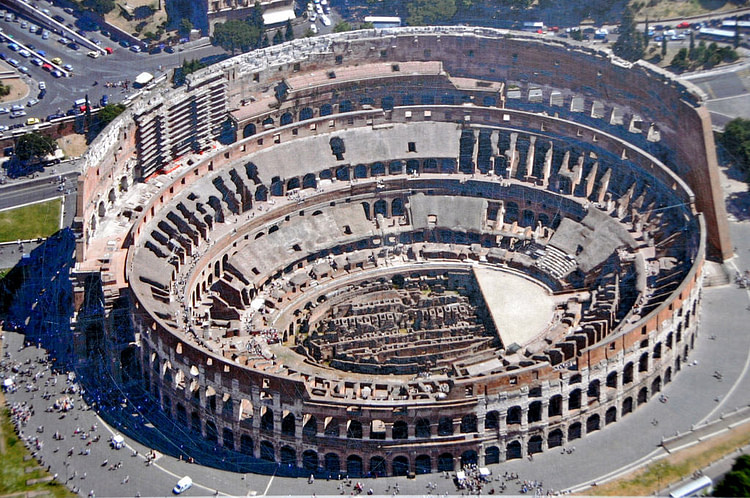
The Colosseum or Flavian Amphitheatre is a large ellipsoid arena built in the first century CE under the Roman emperors of the Flavian dynasty: Vespasian (69-79 CE), Titus (79-81 CE) and Domitian (81-96 AD). The arena was used to host spectacular public entertainment events such as gladiator fights, wild animal hunts and public executions from 80 CE to 404 CE.
PURPOSE & DIMENSIONS
The construction of the Colosseum was begun in 72 CE in the reign of Vespasian on the site that was once the lake and gardens of Emperor Nero ’s Golden House. This was drained and as a precaution against potential earthquake damage concrete foundations six metres deep were put down. The building was part of a wider construction programme begun by Emperor Vespasian in order to restore Rome to its former glory prior to the turmoil of the recent civil war. As Vespasian claimed on his coins with the inscription Roma resurgens, the new buildings --the Temple of Peace, Sanctuary of Claudiusand the Colosseum-- would show the world that 'resurgent' Rome was still very much the centre of the ancient world.
The Flavian Amphitheatre (or Amphiteatrum Flavium as it was known to the Romans) opened for business in 80 CE in the reign of Titus, Vespasian's eldest son, with a one hundred day gladiator spectacular and was finally completed in the reign of the other son, Domitian. The finished building was like nothing seen before and situated between the wide valley joining the Esquiline, Palatine and Caelian hills, it dominated the city. The biggest building of its kind, it had four stories and stood over 45 metres high (150 feet) and measured 189 x 156 metres across. The oval arena itself measured 87.5 m by 54.8 m. The theatre was principally built from locally quarried limestone with internal linking lateral walls of brick, concrete and volcanic stone (tufa). Vaults were built of lighter pumice stone. The sheer size of the theatre was the possible origin of the popular name of Colosseo, however, a more likely origin may have been as a reference to the colossal gilded bronze statue of Nero which was converted to resemble the sun-god and which stood outside the theatre until the 4th century CE.
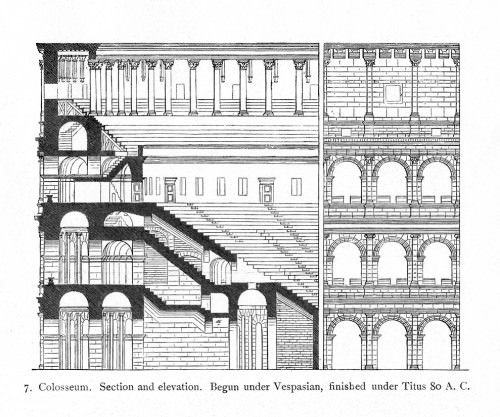
Colosseum Cross-Section
ARCHITECTURE
The theatre was spectacular even from the outside with monumental open arcades on each of the first three floors presenting statue-filled arches. The first floor carried Doric columns, the second Ionic and the third level Corinthian. The top floor had Corinthian pilasters and small rectangular windows. There were no less than eighty entrances, seventy-six of these were numbered and tickets were sold for each. Two entrances were used for the gladiators, one of which was known as the Porta Libitina (the Roman goddess of death) and was the door through which the dead were removed from the arena. The other door was the Porta Sanivivaria through which victors and those allowed to survive the contests left the arena. The final two doors were reserved exclusively for the Emperor's use.
Inside, the theatre must have been even more impressive when the three tiers of seats were filled with all sections of the populace. Encircling the arena was a wide marble terrace ( podium ) protected by a wall within which were the prestigious ring-side seats or boxes from where the Emperor and other dignitaries would watch the events. Beyond this area, marble seats were divided into zones: those for richer private citizens, middle class citizens, slaves and foreigners and finally wooden seats and standing room in the flat roofed colonnade on the top tier reserved for women and the poor. On top of this roof platform sailors were employed to manage the large awning ( velarium ) which protected the spectators from rain or provided shade on hot days. The different levels of seats were accessed via broad staircases with each landing and seat being numbered. The total capacity for the Colosseum was approximately 45,000 seated and 5,000 standing spectators. One of the oldest depictions of the Colosseum appeared on the coins of Titus and shows three tiers, statues in the upper external arches and the large column fountain - the Meta Sudans - which stood nearby.
EMPERORS TITUS AND CLAUDIUS WERE NOTED FOR SHOUTING AT THE GLADIATORS FROM THEIR SEATS IN THE COLOSSEUM.
The scene of all the action --the sanded arena floor-- was also eye-catching. It was often landscaped with rocks and trees to resemble exotic locations during the staging of wild animal hunts ( venatiories ). There were also ingenious underground lifting mechanisms which allowed for the sudden introduction of wild animals into the proceedings. On some occasions, notably the opening series of shows, the arena was flooded in order to host mock naval battles. Under the arena floor (and visible to the modern visitor) was a maze of small compartment rooms, corridors and animal pens.
GAMES & SHOWS
Although historically tied to earlier Etruscan games which emphasised the rites of death, the shows in the Roman arenas were designed simply to entertain, however, they also demonstrated the wealth and generosity of the Emperor and provided an opportunity for ordinary people to actually see their ruler in person. Emperors were usually present, even when they had no particular taste for the events such as Marcus Aurelius. Titus and Claudius were noted for shouting at the gladiators and other members of the crowd and Commodus himself performed in the arena hundreds of times. One vestige of the earlier Etruscan tradition continued, however, with the presence of the attendant whose job was to finish off any fallen gladiator by a blow to the forehead. This attendant wore the mythical costume of either Charon (the Etruscan minister of Fate) or Hermes, the messenger god who accompanied the dead down to the underworld. The presence of the Vestal Virgins, the Pontifex Maximus and the divine Emperor also added a certain pseudo-religious element to the proceedings, at least in Rome.
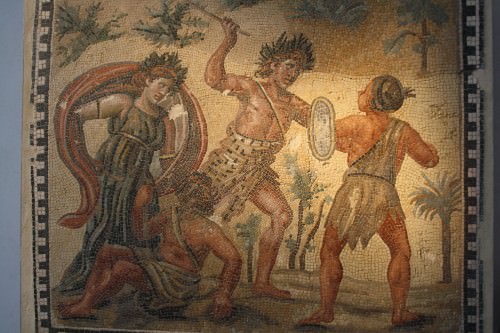
Roman Mosaic
However, blood sports and death were the real purpose of the spectacular shows and an entire profession arose to meet the massive entertainment requirements of the populace - for example under Claudius there were 93 games a year. Spectacles often lasted from dawn till nightfall and the gladiators usually kicked-off the show with a chariot procession accompanied by trumpets and even a hydraulic organ and then dismounted and circled the arena, each saluting the emperor with the famous line: Ave, imperator, morituri te salutant! (Hail, Emperor, those who are about to die salute you!).
Comic or fantasy duels often began the day's combat events, these were usually fought between women, dwarfs or the disabled using wooden weapons. The following blood sports between various classes of gladiators included weapons such as swords, lances, tridents, and nets and could also involve female combatants. Next came the animal hunts with the bestiarii -- the professional beast killers. The animals had no chance in these contests and were most often killed at a distance using spears or arrows. There were dangerous animals such as lions, tigers, bears, elephants, leopards, hippopotamuses and bulls but there were also events with defenceless animals such as deer, ostriches, giraffes and even whales. Hundreds, sometimes even thousands of animals, were butchered in a single day's event and often brutality was deliberate in order to achieve crudeliter -- the correct amount of cruelty.
Under Domitian, dramas were also held in the Colosseum but with a bloodthirsty realism such as using real condemned prisoners for executions, a real Hercules was burned on a funeral pyre and in the role of Laureolus a prisoner was actually crucified. The Colosseum was also the scene of many executions during the lunch-time lull (when the majority of spectators went for lunch), particularly the killing of Christian martyrs. Seen as an unacceptable challenge to the authority of Pagan Rome and the divinity of the Emperor, Christians were thrown to lions, shot down with arrows, roasted alive and killed in a myriad of cruelly inventive ways.
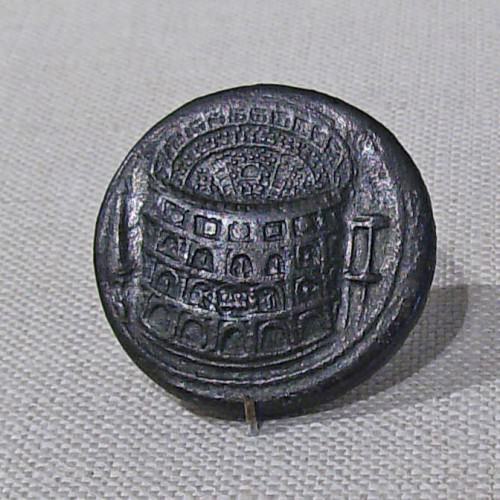
Bronze Sestertius with Colosseum
LATER HISTORY
In 404 CE, with the changing times and tastes, the games of the Colosseum were finally abolished by Emperor Honorius, although condemned criminals were still made to fight wild animals for a further century. The building itself would face a chequered future, although it fared better than many other imperial buildings during the decline of the Empire. Damaged by earthquake in 422 CE it was repaired by the emperors Theodosius II and Valentinian III. Repairs were also made in 467, 472 and 508 CE. The venue continued to be used for wrestling matches and animal hunts up to the 6th century CE but the building began to show signs of neglect and grass was left to grow in the arena. In the 12th century CE it became a fortress of the Frangipani and Annibaldi families. The great earthquake of 1231 CE caused the collapse of the southwest facade and the Colosseum became a vast source of building material - stones and columns were removed, iron clamps holding blocks together were stolen and statues were melted for lime. Indeed, Pope Alexander VI actually leased the Colosseum as a quarry.Despite this crumbling away though, the venue was still used for the occasional religious procession and play during the 15th century CE.
From the Renaissance period both artists and architects like Michelangelo and later tourists on their Grand Tour took a renewed interest in Roman architecture and ruins. As a consequence, in 1744 CE Pope Benedict XIV prohibited any further removal of masonry from the Colosseum and consecrated it in memory of the Christian martyrs who had lost their lives there.This, however, did not stop locals using it as an animal stables and its neglect is reflected in the curious work of Richard Deakin who in 1844 CE catalogued over 420 plant varieties thriving in the ruin, some rare and even locally unique -- perhaps originating from the food given to the exotic animals all those centuries before. The 19th century CE did, though, begin to see the fortunes of the once great amphitheatre improve. The Papal authorities sought to restore parts of the building, notably the east and western ends, with the latter being supported by a massive buttress. Finally, in 1871 CE the Italian archaeologist Pietro Rosa removed all of the post-Roman additions to reveal, despite its degradation, a still magnificent monument, a poignant and enduring testimony to both the skills and the vices of the Roman world.
Colossi of Memnon › Origins
Definition and Origins

The Colossi of Memnon (also known as el-Colossat or el-Salamat) are two monumental statues representing Amenhotep III(1386-1353 BCE) of the 18th Dynasty of Egypt. They are located west of the modern city of Luxor and face east looking toward the Nile River. The statues depict the seated king on a throne ornamented with imagery of his mother, his wife, the god Hapy, and other symbolic engravings. The figures rise 60 ft (18 meters) high and weigh 720 tons each; both carved from single blocks of sandstone.
They were constructed as guardians for Amenhotep III's mortuary complex which once stood behind them. Earthquakes, floods, and the ancient practice of using older monuments and buildings as resource material for new structures all contributed to the disappearance of the enormous complex. Little of it remains today except for the two colossal statues which once stood at its gates.
Their name comes from the Greek hero Memnon who fell at Troy. Memnon was an Ethiopian king who joined the battle on the side of the Trojans against the Greeks and was killed by the Greek champion Achilles. Memnon's courage and skill in battle, however, elevated him to the status of a hero among the Greeks. Greek tourists, seeing the impressive statues, associated them with the legend of Memnon instead of Amenhotep III and this link was also suggested by the 3rd century BCE Egyptian historian Manetho who claimed Memnon and Amenhotep III were the same person.
THE SITE BECAME LEGENDARY FOR DIVINATION AFTER ONE OF THE STATUES BEGAN MAKING NOISES INTERPRETED AS ORACLES.
The Greek writers referred to the entire complex regularly as the Memnonium and the site became legendary for divination after one of the statues began making noises interpreted as oracles. From ancient times to the present the Colossi have been a popular tourist attraction and in the present day one can see graffiti inscribed on the base from visitors thousands of years ago.
AMENHOTEP III & THE GLORY OF EGYPT
Amenhotep III lived during the period of the New Kingdom (c. 1570-c. 1069 BCE) in which Egypt became a country of international power and wealth. His father, Thutmose IV (1400-1390 BCE), left his son a prosperous and stable empire of substantial riches which the new king used wisely. He was only twelve years old when he came to the throne and married Tiye, a girl of only eleven or twelve, who came from a prestigious family. Tiye was given the title of Great Royal Wife, an honor which even Amenhotep III's mother had not been accorded. This title reflects the great status of both Amenhotep III and Tiye as a royal couple of impressive power.

Amenhotep III
In keeping with the traditions of powerful pharaohs, Amenhotep III almost instantly embarked on grand building projects throughout Egypt. His vision was of a land so splendid and opulent that it would leave one in awe and the over 250 buildings, temples, statuaries, and stele he commissioned attest to his success in realizing this. His pleasure palace at Malkata, on the west bank of the Nile near Thebes, covered over 30,000 square meters (30 hectares) and included spacious apartments, conference rooms, audience chambers, a throne room and receiving hall, a festival hall, libraries, gardens, storerooms, kitchens, a harem, and a temple to the god Amun.
AMENHOTEP III COMMISSIONED SO MANY MONUMENTS THAT LATER EGYPTOLOGISTS ATTRIBUTED TO HIM AN EXTRAORDINARILY LONG REIGN.
Amenhotep III commissioned so many monuments, temples, and other building projects that later Egyptologists attributed to him an extraordinarily long reign because it seemed impossible that one king could have had the resources to accomplish what he did in less than 100 years. Amenhotep III, of course, ruled for far less time but was so effective a king that he accomplished far more than most.
He was a master of diplomacy who placed other nations in his debt through lavish gifts to ensure they would be inclined to bend to his wishes. His generosity to friendly kings was well established and he enjoyed profitable relationships with the surrounding nations which filled Egypt's royal treasury. He maintained the honor of Egyptian women in refusing requests to send them as wives to foreign rulers, claiming that no daughter of Egypt had ever been sent to a foreign land and would not be sent under his reign. While other nations may not have felt at all flattered by this policy, it expressed an adherence to tradition and cultural values which won their respect.
Throughout his reign, Amenhotep III improved upon his father's very sound policies of rule and in religion he did likewise.Amenhotep III was an ardent supporter of the ancient religion of Egypt and expressed his interest lavishly in patronage of the arts and in building projects. Among the most opulent was his mortuary temple complex which included the massive figures of the Colossi of Memnon.
THE GRAND MORTUARY COMPLEX
Amenhotep III's mortuary complex was larger and greater in every way than anything previously built in Egypt. At the time of its construction it was more magnificent and awe-inspiring than the Temple of Karnak. It covered over 86 acres (35 hectares) and included numerous rooms, halls, porticos and plateaus which probably mirrored the vision of the Field of Reeds, the Egyptian paradise. In their time, the colossal statues of the king would have flanked a walkway, probably ornamented with statuary, leading to the complex.
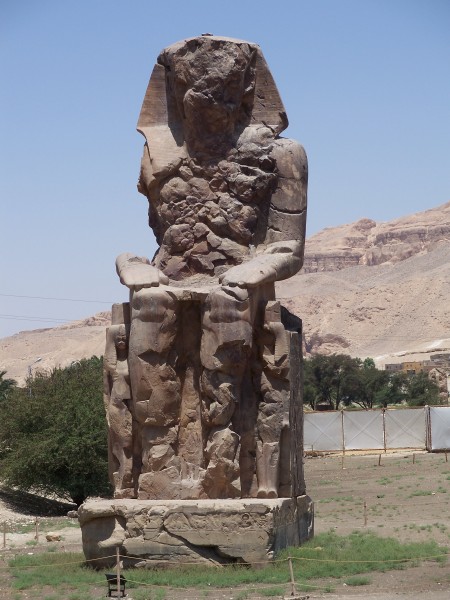
Colossus of Memnon
There was an open sun court adjacent to the temple surrounded by three rows of columns and, on the north and south sides, statues of the king as Osiris in mummified form. This was in keeping with the tradition of kings associating themselves with Horus during their reign and with his father Osiris in death. The statues were 26 feet (8 meters) tall; those on the south side of the court wore the white crown of Upper Egypt while those on the north wore the red crown of Lower Egypt.
The statues of the king symbolized his rule over all Egypt, identified him with Osiris, and made clear the king's wealth and power. Osiris was believed to have been the first king of Egypt and the Lord and Judge of the Dead. Even though kings before and after Amenhotep III associated themselves with Osiris in their mortuary complexes, Amenhotep III made his close relationship with the god both more apparent and more impressive.
Most Egyptians would never have been allowed into the complex to see these statues, the sun court, or anything else but they would have been aware of the great figures who stood at the gates which could be seen for miles from every direction.Egyptologist Gay Robins notes that the statues' function "was to guard the entrance to the complex, to inspire awe at the king's might, and to celebrate the acheivements of the state" (130). Their ability to awe is well established by writers from ancient times to the present owing to their sheer size and the amount of effort it must have taken to create them.
THE GUARDIANS OF THE GATE
The statues were carved from single blocks of quartzite sandstone quarried either from the area around Memphis (near modern-day Cairo) in the north or from the region near Aswan in the south. If quarried from the north, the blocks had to be transported overland 400 miles (645 km) and, if from the south, 147 miles (238 km) as they were too heavy to move by ship on the Nile. How the stones were transported is unknown but they were most likely pushed on sleds in the same way blocks of stone were moved to the site of Giza for construction of the pyramids.

Side Panel, Colossus of Memnon
In their day, the guardians at the gate would have been clear depictions of Amenhotep III as god-king although they have sat in ruin now for centuries and, today, the figures are unrecognizable. He was deified in his lifetime and venerated by his own cult for centuries afterward. The base of the works depict his mother Mutemwiya and wife Tiye on the front and Hapy, the god of the Nile, on the side. All three of these figures symbolized rebirth. Gay Robins comments on the significance of the mother/wife figures:
Together these women represented the combined mother/consort role of the sky goddess through which the sun god renewed himself so that their presence symbolized the king's perpetual renewal through self-regeneration.(130)
Art in ancient Egypt was created to be functional and the Colossi are no exception. The statues would have served not only to guard the complex but, through a kind of sympathetic magic, allow the king to inhabit them and receive strength and sustenance from the symbolic imagery. The figures of Mutemwiya and Tiye are not just honorary ornamentation but served a specific purpose according to Egyptian belief. Mortuary statues placed in tombs were considered homes for the soul of the deceased when it visited earth and needed to be provided with food and drink offerings. In this same way, the Colossi were also thought to be more than simple stone images and especially after one of them began to sing.
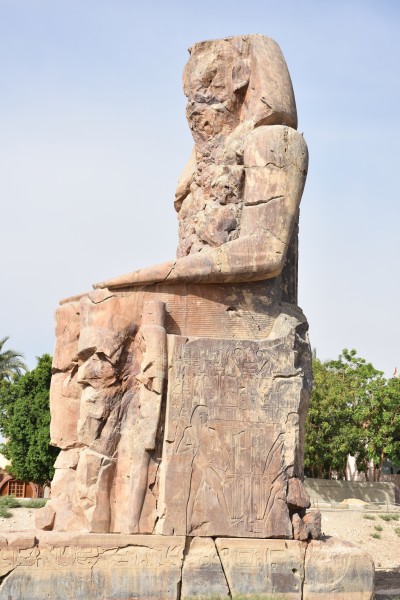
Colossus of Memnon (Side View)
THE SINGING STATUE
The Greek historian Strabo (65 BCE-23 CE) is the first to record the sound which would later be described as singing, the sound of a lyre, brass instruments, a broken harp or lyre string, and a slap or blow. Strabo noted in his Geography that an earthquake shattered the upper part of the northern statue which, thereafter, made the noise every day at dawn. After visiting the site, Strabo writes:
Here are two colossi, which are near one another and are each made of a single stone; one of them is preserved, but the upper parts of the other, from the seat up, fell when an earthquake took place, so it is said. It is believed that once each day a noise, as of a slight blow, emanates from the part of the latter that remains on the throne and its base; and I too, when I was present at the place with Aelius Gallus and his crowd of associates, both friends and soldiers, heard the noise at about the first hour. (XVII.46)
Strabo adds that he cannot be sure where the sound came from, whether the statue itself, the base, or from one of the people standing nearby, but claims he will accept any explanation other than that of the stone image "speaking" in some way.
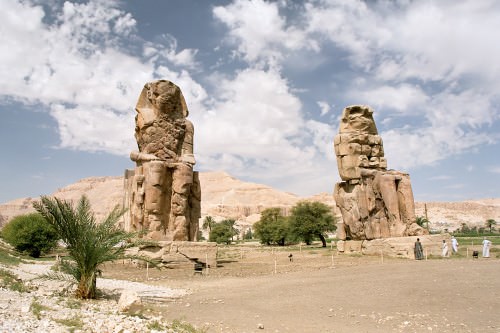
Colossi of Memnon
Many other ancient writers record the singing statue and the graffiti one may still see at the base records whether a visitor heard or did not hear the sound. People from all classes of society and regions traveled to the site for divination purposes, to ask a question and hope for the gods' answer, and would be rewarded - or disappointed - by the experience. This practice continued until the Roman emperor Septimus Severus (193-211 CE) visited in either 196 or 199 CE and did not hear the sound. Hoping to curry favor with the oracle, he had the northern statue repaired; afterwards, the sounds stopped completely.
It is popularly supposed that the sound was caused by dew drying inside the cracks of the statue and the porus rock was simply responding to the oncoming heat of the morning after a cool night. Similar "mysterious" sounds can be heard from objects like guard rails on roads between dawn and mid-morning in the present day.
Severus' repair of the statue sealed the cracks of the upper body and no doubt saved it from collapse but the site dwindled in popularity afterwards. With no miraculous oracle to answer their questions at the Memnonium, people went to other sites with their supplications and prayers. The site remained a tourist attraction, however, for the experience of seeing the enormous statues rising against the background of the far mountains and the ruins of the mortuary complex behind them. The site was already in ruin in Strabo's day and the temple and inner statues are now long gone but the Colossi of Memnon remain as reminders of the grandeur and vision of ancient Egypt.
The Tombs of Goguryeo › Origins
Ancient Civilizations
Goguryeo ( Koguryo ) ruled northern Korea during the Three Kingdoms period from the 1st century BCE to 7th century CE, and the best evidence of the kingdom's prosperity and artistry can be found in the many surviving tombs of the period. The murals inside many of the tombs are an invaluable insight into the ceremonies, warfare, architecture, and daily life of ancient Korea. The tombs are designated a World Heritage Site by UNESCO.
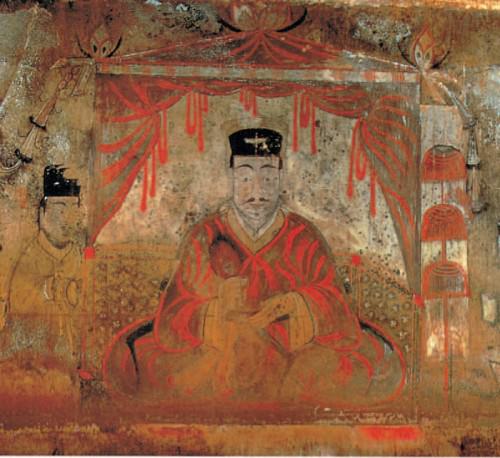
Tong Shou, Goguryeo Tomb Mural
ARCHITECTURE
There are over 10,000 Goguryeo tombs of one sort or another, with the earliest ones taking the form of stone cairns using river cobbles. By the 4th century CE, square tombs were constructed and placed within pyramids made of cut-stone blocks. Later tombs were built in the form of huge earth mounds which most often have a rectangular base. The earth was mixed with lime and small pebbles to make it firmer and so better keep its outward shape. Additional layers of stones and clay mixed with lime and charcoal were placed immediately over the inner stone chamber and under the earth mound to make the tombwaterproof. These precautions have helped protect the murals inside many tombs. The border of the mound could be marked out using river cobbles but many of these markers have long-since disappeared.
Inside the mound are stone slab or brick-lined chambers accessed by a horizontal passageway. The thick stone slabs are cut for the purpose and may be either granite or limestone. Again, some inner chambers were lined with lime mortar and have drainage channels to protect them from the elements and to minimise water damage over the centuries. The floors of chambers are cemented with a mix of soil, lime, charcoal, pebbles, and sand with the whole covered in lime mortar.

Tomb of Gwanggaeto the Great
Some mounds have a single chamber while others have additional rooms off the main burial chamber which are separated from each other by stone columns. The entrance passage can lead either directly to the main tomb chamber or to a side chamber. The coffin or coffins were placed on stone bars to keep them off the ground and, later, on a lime-plastered table.Sometimes there is a stone table set into the wall for religious objects and a small traditional fireplace, presumably for use in the burial service. The main chamber was closed off using a single or double stone door. Many Goguryeo tomb chambers include corbelled roofing of various designs, octagonal pillars supporting stone cross-beams, niched walls, and even pivoted stone doors. In general design the tombs display the close cultural ties between the kingdom and ancient China.
THE LARGEST TOMB IS THE 11-METRE-HIGH PYRAMID OF KING GWANGGAETO THE GREAT AT KUNGNAESONG.
Although most tombs are more modest hemispherical earth mounds built over a square base and with a single interior tomb chamber of stone, some tombs are spectacularly grandiose. The largest tomb is at the former capital Kungnaesong (modern Tonggou) and thought to be that of King Gwanggaeto the Great (r. 391–412 CE), hence its popular name 'the General's Tomb.'75 metres long, 11 metres high, and using 1,100 blocks measuring 3 x 5 metres, the tomb also has four smaller dolmen -like structures at each corner. Another important tomb is that of Tong Shou, last ruler of Taebang. Located near Pyongyang, an inscription dates the tomb to 357 CE. Its central chamber has 18 limestone columns and wall paintings; it is surrounded by four smaller chambers.
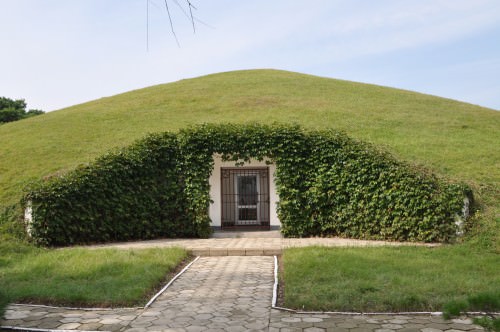
Goguryeo Mound Tomb, Kangso
WALL PAINTINGS
An important Goguryeo artform was wall painting. Around 80 Goguryeo tombs contain murals, either painted directly onto the stone chamber walls or applied to a lime plaster. Bright colours and flowing outlines are a typical feature of Goguryeo paintings. Perhaps the most famous surviving examples are found in the 5th-century CE Muyonchong or 'Tomb of the Dancers' at Kungnaesog (modern Tonggou). One mural, which gives its name to the tomb, has rows of servants dancing with arms raised as they bid farewell to their master who is leaving the family home on horseback, presumably a metaphor for his departure into the next life. The dancers wear either long-sleeved robes or jackets and trousers tied at the ankles.
In several tombs there are paintings of the actual occupant, and one of the best preserved is from a side chamber of Tomb No. 3 at Anak, 357 CE. The man is identified by an inscription in the tomb as Tong Shou, the last ruler of the Chinese commandery of Taebang. He is depicted receiving officials while sitting on a jwasang chair. The figure wears a double-hat and sleeved robe, and is holding a feather fan. The various officials at the audience are painted in different sizes to represent their different ranks.
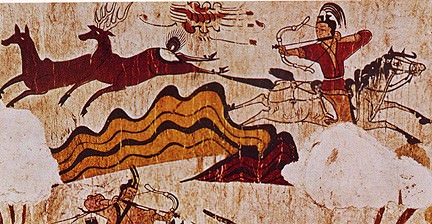
Hunting Scene, Goguryeo Tomb Mural
Hunting scenes are a very popular choice of painted scene, and one of the most celebrated is from the wall of the burial chamber within the Muyongchong tomb. The dynamic scene is composed of two distinct areas separated by a grove of trees.On the right side are two ox-drawn carriages while on the left hunters on horseback fire arrows at fleeing deer and a tiger which leap between trees and mountains.
Other chambers have paintings of warriors on horseback, mythical animals, animal tamers, acrobats, religious ceremonies, political processions, and a myriad of details of daily life and architecture. As with their architectural design, the murals of Goguryeo tombs display more Chinese influence with constellations painted on many of the ceilings, roof corbels painted with the lotus flowers so common to Buddhist art, and, above all, images of the Chinese animals of the four directions on the walls.
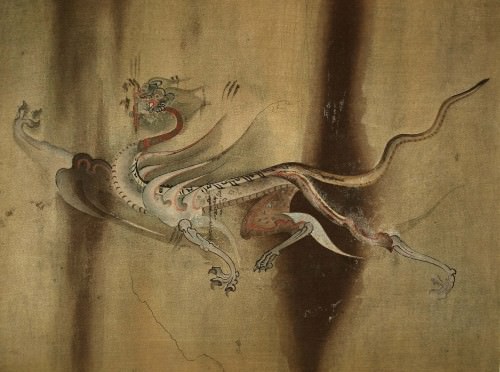
White Tiger, Goguryeo Tomb Mural
Constellation scenes usually include a sun and moon, which indicate east and west respectively. The sun is typically represented by a three-legged crow with a peacock crest inside a wheel while the moon can take three different forms: a pair of toads, rabbits, or cinnamon trees, again inside a wheel. These were important symbols of the state and may represent a link with shamanism and the importance of nature in early Korean culture. The most common constellations depicted are Saggitarius and the Great Bear and, besides a link with Taoism (where they represent life and death respectively), indicate the close relation Koreans assumed between the stars and human affairs.
The animals of the four directions are common to a great many tombs, and they are the Blue Dragon (east), White Tiger (west), Red Phoenix (south), and Black Tortoise-Snake (north). One creature was painted on each wall of the main tomb chamber, which is in contrast to Chinese tombs where they only appear on ceilings, and they collectively acted as guardians. It is likely that just as Korean painters learned from their Chinese counterparts, so too, they passed on their knowledge to artists in Japan as many tombs there are similar in their artistic decoration.

Gilt-bronze Buddha, Goguryeo Kingdom
ARTEFACTS
Tombs are also a source of artefacts but the tendency to build easily accessible horizontal entrances has meant that many Goguryeo tombs were looted long ago. Some few surviving art pieces include two gilt-bronze crowns and jewellery (rings, earrings, bracelets, and hairpins) which are testimony to the craftsmanship of their creators. Very few examples of Goguryeo pottery have survived and are of dubious provenance. More numerous are bronze and gilt-bronze figurines of the Buddhawhich typically show Northern Wei influence with a flaming mandorla and flanked by seated bodhisattvas.
[bks]
LICENSE
Article based on information obtained from these sources:with permission from the Website Ancient History Encyclopedia
Content is available under License Creative Commons: Attribution-NonCommercial-ShareAlike 3.0 Unported. CC-BY-NC-SA License